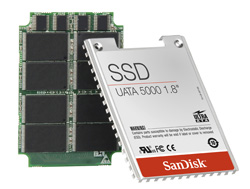Solid State Disk show promise for notebooks, tablets


SanDisk has announced a 32GB Ultra ATA 5000 1.8-inch SSD "drive" (it's really flash memory). Engadget brings word that SSD prices are beginning to fall:
According to SanDisk, their 32GB SSD could increase the end-user price by "around $600" when released in laptops computers in the first half of 2007. That's down -- way down -- from the $900 to $1,400 premium we're currently paying for SSD equipped gear.
For those not familiar with the technology, a Solid State Disk (sometimes called a Solid State Drive) is defined by Wikipedia as:
A data storage device that uses non-volatile memory such as flash, or volatile memory such as SDRAM, to store data, instead of the spinning platters found in conventional hard disk drives. While not technically "disks" in any sense, these devices are so named because they are typically used as replacements for disk drives in situations where conventional drives are impractical.
Some of the benefits of SDDs include: no moving parts (which makes them practically silent), lower power consumption, super thin profile, and faster read and boot times:
SSDs based on volatile memory such as SDRAM and are categorized by fast data access, less than 0.01 milliseconds (over 250 times faster than the fastest hard drives in 2004) and are used primarily to accelerate applications that would otherwise be held back by the latency of disk drives.
The problem is that SDDs aren't cheap. Sure US$600 is a lot less than US$900-1400, but keep in mind that only gets you 32GB (US$18.75 per gig.) I think that my Visa card has more memory on it than that. In comparison, a cheap 750GB 3.5-inch rotating HDD can be purchased for as low as US$330, which is 44 cents per GB.
So don't expect to replace the 200GB in your MacBook Pro with an SDD anytime soon, but Moore's Law being what it is, SDDs should drop in price and increase in capacity dramatically over the next couple of years.
Look for these bad boys to appear in computers "in the first half of 2007." Hmmm, time to revive the thin MacBook Pro/iTablet rumors?
More on the new 32GB SanDisk SSD is on their product page.